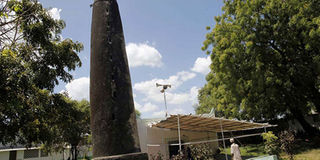Mombasa monument ‘where ghosts roamed’ still stands tall

An image of Mbaraki Pillar in Mombasa taken on December 16, 2019. It is classified as a monument. PHOTO | LABAN WALLOGA | NATION MEDIA GROUP
What you need to know:
- Women performed rituals hoping that the spirits residing in the pillar would provide solutions to fertility problems.
- Mr James Kirkman, a curator, strongly believed the pillar may have been the tomb of a Sheikh of the Changamwe people who lived in Mbaraki.
Standing 50 feet high and located west of Likoni Ferry roundabout in Mombasa town is a 300-year-old pillar believed to have Arab spirits with healing power within its walls.
Mbaraki Pillar is the second oldest monument in the country after Fort Jesus, maintaining its original form of its coral stone structure three centuries later, only leaning slightly at an angle.
Built around 1550, it has been gazetted as a monument. People offered sacrifices locally referred to as kafara at the pillar.
HEALING POWERS
To date, some people still bring their offerings and place them outside the walls as they pray for fulfilment.
“Since I was a child, I used to go with my father to the beach near Mbaraki Pillar and would see people bring an assortment of offerings. Some would place them outside while others took them inside. Some believers still practise this,” said the Coordinator of Coastal Research Unit, Dr Kalandar Khan.
“Many people avoided visiting the pillar due to a belief that it was possessed by ghosts. It was believed that one would get sick if they stepped on the kafara,” Said Dr Khan
Women performed rituals hoping that the spirits residing in the pillar would provide solutions to fertility problems, while the sick brought offerings with the hope of being cured.
DEEP CONTROVERSY
Unlike other mosques, the pillar is not on top of a mosque but around five metres away from a small one believed to have been constructed between 1400 and 1450AD.
The mosque fell into ruin by 1550AD and was rebuilt around 1988. It has a large prayer room, two anterooms and stone-built cisterns for storing water on its northeastern and southwestern corners.
The monument continues to be a source of deep controversy among historians and archaeologists.
Whereas there have been suggestions that it may have served as some kind of landmark or lighthouse, others cite ghostly tales.
There are those who believe the 300-year-old pillar may have been the tomb of an important person.
SHEIKH'S TOMB
Initially, there were settlements around the coastal town. The Wachangamwe people resided around Mama Ngina Drive and extended their settlements towards Mbaraki.
“When a group of Muslims lived close together, it was customary that they build a mosque around the residing place,” Said Dr Khan.
“People believed that when someone died, a pillar was built where they were buried to symbolise a male figure,” he added.
Mr James Kirkman, the first curator of Fort Jesus, strongly believed the pillar may have been the tomb of a Sheikh of the Changamwe people who lived in Mbaraki.
Yet no single burial chamber has ever been found inside the pillar.
Is there a site you want us to feature? Write an e-mail to [email protected]





